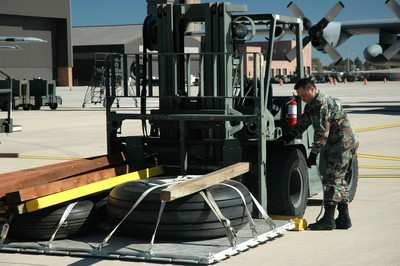MAFFS C-130s Arrived On Scene This Week
Two Air Force Reserve Command firefighting C-130 Hercules
aircraft left Colorado's Peterson Air Force Base this week, to help
battle the raging wildfires in Southern California.

The National Interagency Fire Center in Boise, ID requested
Department of Defense assistance in fighting the fires which put
the wheels in motion for the mobilization of about 30 reservists
from Peterson. The aircraft arrived at Point Mugu Naval Air
Station, CA, where they joined other military aircraft providing
additional firefighting capabilities.
"The Air Force Reserve has had this mission for roughly 15
years," said Capt. Brian McReynolds, a C-130 pilot and member of
the Colorado Springs-based unit. "We have the right people and the
safest equipment available for this mission. This is what we love
to do."
The planes departed with the Modular Airborne Firefighting
System in place. When loaded inside the cargo bay, MAFFS units
convert the aircraft from a transporter to an aerial tanker capable
of dispersing fire-retardant slurry to extinguish wildfires. The
Airmen said they hoped to begin flying missions in California early
Wednesday.

Get A Rare Peek Onboard An ANG MAFFS C-130 Here
"We'll hit the ground right away," said Lt. Col. Dave Condit,
the AFRC MAFFS program coordinator at Peterson AFB. "We may have to
wait until the winds die down just a little bit. As soon as the
winds permit us to get in close to the fire, (we'll start flying
our missions.)"
Crewmembers certified on the MAFFS equipment said their
objective is not to put the fire out, but to follow the lead of
aviators from the Forest Service to lay lines of containment.

"We have a host of support specialists on the ground to help
keep us flying," said the colonel. "It's sort of like a NASCAR pit
stop. When we roll into the pits, we'll stop our engines. (The
ground crew) will run up, refill the aircraft with fuel, slurry and
compressed air, which we need to pump the retardant out. Then we'll
get back in the air as quickly as we can."
The process for replenishing the aircraft can be performed in
eight to 12 minutes, according to officials from Peterson. It is
repeated as often as necessary to sustain firefighting operations
throughout daylight hours.
All of the MAFFS equipped-flying units are currently in the Air
Force's air reserve components -- three in the Air National Guard
and one in AFRC. By law, MAFFS only can be activated when all other
resources have been exhausted.
"We let the civilian tanker fleet take care of the issues
first," said Colonel Condit. "If they need assistance, that's when
the Department of Defense will roll in. We don't compete for
business with civilian (aerial firefighting) companies. Usually if
you see us taking off, you know the situation is pretty
critical."
The typical aerial firefighting mission is inherently dangerous,
which is why the Reserve unit at Peterson AFB only selects the most
experienced aviators for the duty.
"We've got people that wait for years to get an opportunity to
get certified for this mission," said the colonel. "The unit only
takes the most experienced aircrewmembers, and we go through a lot
of training and preparation for this.

"Our target altitude is 150 feet above the ground, which is very
low for an aircraft this size," he said. "It's a hazardous mission,
but we train for it and we're (definitely) prepared. We have a long
and proud history of supporting contingencies overseas, but it's
always great to be able to support the United States in the United
States."
Last year, the 302nd Operations Group's MAFFS mission was
activated by the Forest Service to fight wildfires in the Pacific
Northwest. The unit flew 18 sorties against fires in Idaho, Nevada
and Oregon, dropping 48,600 gallons of retardant.
(Aero-News salutes Maj. James R. Wilson, 302nd Airlift Wing
Public Affairs)
 ANN's Daily Aero-Linx (05.06.25)
ANN's Daily Aero-Linx (05.06.25) ANN's Daily Aero-Term (05.06.25): Ultrahigh Frequency (UHF)
ANN's Daily Aero-Term (05.06.25): Ultrahigh Frequency (UHF) ANN FAQ: Q&A 101
ANN FAQ: Q&A 101 Classic Aero-TV: Virtual Reality Painting--PPG Leverages Technology for Training
Classic Aero-TV: Virtual Reality Painting--PPG Leverages Technology for Training Airborne 05.02.25: Joby Crewed Milestone, Diamond Club, Canadian Pilot Insurance
Airborne 05.02.25: Joby Crewed Milestone, Diamond Club, Canadian Pilot Insurance





